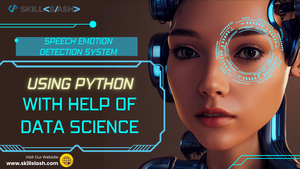Speech Emotion Detection System using Python with help of data science
Corps
Speech Emotion Detection (SED) is a technique that enables machines to detect human emotions from speech signals. The rise of artificial intelligence and machine learning has opened up new possibilities in the field of SED. In this blog, we will explore how to build a Speech Emotion Detection System using Python with the help of Data Science.
Understanding Speech Emotion Detection System
Speech Emotion Detection System is a system that can analyze and classify human emotions based on their speech signals. It can analyze the audio signal to detect the emotional state of the speaker. The system uses various features extracted from the audio signal, such as pitch, intensity, and duration, to classify the emotion. There are several techniques used for Speech Emotion Detection, such as Mel Frequency Cepstral Coefficients (MFCC), Prosody features, and deep learning techniques.
Steps to Build Speech Emotion Detection System
Here are the steps to build a Speech Emotion Detection System using Python:
Step 1: Collect the dataset
The first step is to collect the dataset. You can use various datasets available online, such as the RAVDESS dataset or the EmoDB dataset. The dataset should contain audio files of different emotions, such as happy, sad, angry, and neutral.
Step 2: Preprocessing the audio files
The next step is to preprocess the audio files. Preprocessing involves converting the audio files into a format that can be used by the machine learning algorithm. You can use the librosa library in Python to preprocess the audio files. Librosa is a python library for analyzing audio and music.
Step 3: Extracting features from audio files
The next step is to extract features from the audio files. You can use various feature extraction techniques, such as Mel Frequency Cepstral Coefficients (MFCC) and Prosody features. MFCC is a widely used feature extraction technique for speech analysis. MFCCs are a representation of the short-term power spectrum of a sound, based on a linear cosine transform of a log power spectrum. Prosody features include pitch, duration, and intensity.
Step 4: Creating a machine learning model
The next step is to create a machine learning model that can classify the emotions in the audio files. You can use various machine learning algorithms, such as Support Vector Machine (SVM), K-Nearest Neighbors (KNN), and Random Forest. In this blog, we will use the SVM algorithm.
Step 5: Train the model
The next step is to train the model on the dataset. You can use the scikit-learn library in Python to train the SVM model. Scikit-learn is a python library for machine learning.
Step 6: Testing the model
The final step is to test the model on new audio files. You can use the same feature extraction techniques used in step 3 to extract features from the new audio files. Then, you can use the SVM model trained in step 5 to classify the emotions in the new audio files.
Conclusion
Speech Emotion Detection System is a powerful tool that can help us analyze and classify human emotions from speech signals. In this blog, we explored the steps to build a Speech Emotion Detection System using Python with the help of Data Science. We used various techniques, such as feature extraction and machine learning algorithms, to create a system that can classify the emotions in audio files.
Look into Skillslash's Data science course in Kolkata and Data science course in Mumbai to get started on this exciting new career.







commentaires